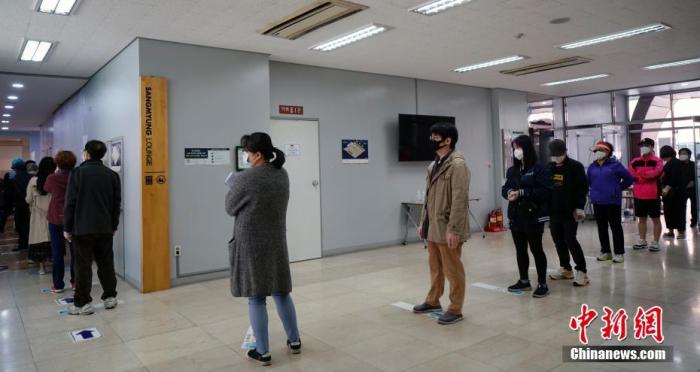China News Service, June 14th. According to South Korean media reports on June 13, the impact of the New Crown Virus epidemic on the Korean job market is showing. The number of employees in May has fallen by more than 390,000, and the unemployment rate and unemployment rate have reached the level since 1999. The highest level.
In this regard, the South Korean Deputy Prime Minister and Minister of Planning and Finance believes that the economic contraction of the trading target countries has led to a reduction in South Korean exports, which has a negative impact on manufacturing employment.
According to the “Employment Trends in May 2020” released by the Korean Statistics Agency on the 10th, the number of employed people in South Korea was 26.93 million in May 2020, a decrease of 392,000 from the same period last year.
Data map: The elections were held under the Korean epidemic. At a polling station in Seoul, South Korea, people kept their distance and waited in line to vote. China News Service reporter Zeng Nashe
Since March this year, the number of employed persons has decreased for the third consecutive month, a decrease of 195,000 in March and 476,000 in April. This is the first time since the global financial crisis. Affected by the global financial crisis, South Korean employment has decreased for four consecutive months from October 2009 to January 2010. The reductions were 6,000 in October 2009 and 34,000 in November. , 34,000 in December, and 10,000 in January 2010.
According to the Statistics Department, the number of employed people decreased mainly in the face-to-face service industry. However, after the transition to the life-defense epidemic prevention system in early May, the decline in accommodation, catering, education services and other industries has narrowed compared with April.
In terms of age, except for people aged 60 and above, the number of employed people of all ages in South Korea has decreased. Among them, the 40-49-year-old group had the highest decrease, reaching 187,000; the 30-39-year-old group decreased by 183,000, and the 20-29-year-old group decreased by 134,000. The number of people aged 60 and over increased by 302,000.
In terms of industries, the number of employed persons in wholesale and retail, accommodation and catering, associations and organizations, repair and other personal services, education services, manufacturing, etc. has decreased. Health and social welfare services, agriculture, forestry and fisheries, transportation and The warehouse industry has increased.
The number of unemployed persons was 1.278 million, an increase of 133,000 year-on-year; the unemployment rate was 4.5%, an increase of 0.5 percentage points year-on-year. The employment rate of people aged 15 to 64 years was 65.8%, down 1.3 percentage points. The number of job quits was 578,000, a year-on-year increase of 39,000.
The expanded unemployment rate, which reflects the somatosensory unemployment rate, rose 2.4 percentage points from a year ago to 14.5%, the highest value in the same period since the implementation of the 2005 statistics. The youth unemployment rate of expansion is 26.3%, an increase of 2.1 percentage points year-on-year, and also the highest value in the same period since 2015.
According to reports, South Korea's economically active population was 28.209 million, a year-on-year decrease of 259,000; the non-economically active population increased by 555,000 to 16.548 million.
The report pointed out that the current employment situation in South Korea means that the negative impact of the new coronavirus epidemic on the economy has become a reality. There are concerns that as the global pandemic continues in the future, the possibility of further deterioration cannot be ruled out.
In addition to employment, the impact of the epidemic on the financial sector is gradually appearing. The delay rates of major commercial banks in South Korea have all risen in May. Although the increase is not large, the financial industry believes that the impact of the epidemic will be officially launched in the second half of 2020 appear.
In response to this situation, the South Korean government has issued a package of policies to stabilize employment, including the rapid provision of more than 550,000 jobs, the issuance of employment stability support and emergency employment stability support, etc., and has submitted a third round of supplementary budget to Congress . Hong Nanji emphasized that in order to quickly respond to the rising uncertainty in the job market, the supplementary budget should be finalized in the shortest time.

